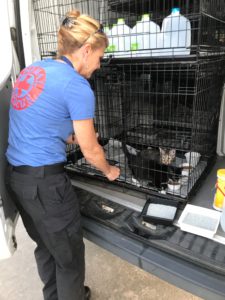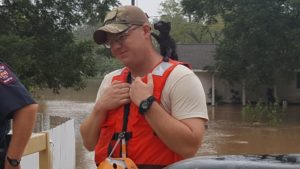By taking refuge on top of a mattress floating in water, a cat named Rudy survived without food for 11 days in a Texas house flooded almost to the ceiling.
Community cats climbed up trees and became trapped amid rising water levels until caregivers could find help to get them rescued and brought to safety.
Cats were the last animals rescued from a hoarding situation also involving dogs, birds, and reptiles, after the owners abandoned the flooded house. Now, many have already been adopted or will be soon, including kittens who were flown to an adoption center in Jackson Hole, WY.
These are only a few of the distressing conditions in Texas caused by Hurricane Harvey, a Category 4 storm that battered parts of the state. And these are also the amazing tales of rescue efforts by Catherine Wilbert of the CATNIP Foundation at Big Sky Ranch in Folsom, LA, made possible in part from an emergency grant from Alley Cat Allies.
After Hurricane Harvey made landfall in Texas on August 25, and moved across Louisiana, causing life-threatening flooding, Alley Cat Allies rushed to action. We deployed an expert, bilingual disaster response team to assist with the care and TNR of community cats, and provided emergency funds to local organizations to aid in relief efforts. Our assistance has helped these organizations save cats’ lives. These are some of their stories.
Collaborating to Protect Cats

Catherine Wilbert of the CATNIP Foundation cares for rescued cats.
The CATNIP Foundation has been rescuing, housing, transporting, and providing medical care for animals, especially cats, affected by the hurricane in Texas. The grant from Alley Cat Allies has helped offset the expenses incurred doing this lifesaving work. Without Alley Cat Allies’ support, Wilbert says the relief efforts, which are “far from over,” would have been “difficult if not impossible.”
As of mid-September, Wilbert and her group made three trips to Texas (one to transport animals from Austin Pets Alive! and two to rescue animals in the Houston area). She is gearing up for another. The rescue trips are weeklong efforts to save the animals trapped by flooding, stuck in houses, buildings, and trees only accessible by boat.
“We were getting call after call, I couldn’t get home [to go back to Texas] to help fast enough,” says Wilbert.
The CATNIP Foundation is a rescue organization that focuses on proactive solutions to save animals’ lives, like Trap-Neuter-Return (TNR) and low-cost spay and neuter, and is a member of our Feral Friends Network. The CATNIP Foundation’s sanctuary, which houses both feral and adoptable cats, had 188 cats before the hurricane. Now, it has about 250, with five pregnant mothers about to deliver, says Wilbert. She estimates half of the cats are adoptable, and luckily, many cats rescued from the floods have been adopted already.
Wilbert says her group has been able to make a considerable impact because of its collaboration with other animal welfare organizations.
“I think the big moral to the story is: We’re very much proponents of collaboration,” says Wilbert. “And everybody needs to work together.”
As Wilbert and her team traveled hundreds of miles around southeastern Texas, TNR didn’t stop. During relief efforts, she met a family who cared for five cats, each of whom needed to undergo TNR. Wilbert connected the family with someone who carried out TNR in the area.
Wilbert says it’s especially important to help community cats in disasters, because after last year’s floods in Louisiana, she saw that they were often forgotten about. (While you shouldn’t try to evacuate feral cats in disasters because they’ll do best on their own, following their instincts, they’re often in need of food and water after the danger passes). Even cats who typically have multiple caregivers in the community are often left on their own in the aftermath of disasters.
Alley Cat Allies is proud to support the work of the CATNIP Foundation as it continues to provide relief to all cats affected by Harvey.
Rescuing Thousands of Animals
Before Harvey even made landfall in Texas, nonprofit Austin Pets Alive! took in hundreds of animals from shelters in coastal areas that were in the hurricane’s direct path.
Once the storm hit, “it was clear we needed to be on the ground,” says Mary Heerwald, the group’s director of communications.
Some three weeks after Harvey hit, the group had cared for about 2,500 pets directly affected by the hurricane. A grant from Alley Cat Allies helped the group increase its capacity to care for the more than 1,000 cats who’d been taken inincluding about 50 pregnant cats and tiny bottle babies, says Heerwald.
“The support that we’ve received has literally been the only way we’ve been able to save so many lives,” Heerwald says, citing the help she received from Alley Cat Allies and other organizations. “It has had a direct impact on the number of animals that have been able to be rescued, taken in, and cared for.”
Austin Pets Alive! was one of the first organizations helping to place rescued animals, getting them to foster homes and other shelters. It set up a staging area for animals in a parking lot in the town of Katy, outside of Houston, which was the closest the group could get because of flooding.
“There were cats that had been taken [by rescuers] off the tops of cars surrounded by a sea of water. There were dogs and cats kept in kennels in houses that had been evacuated and flooding. There were animals that had literally been swimming for hours before they were rescued from the water,” says Heerwald.
Austin Pets Alive! worked with Houston Pets Alive! to set up a temporary shelter in Houston, and it also set up one in Austin. The number of cats in foster care has doubled, and for dogs, it’s tripled. Like Alley Cat Allies, Austin Pets Alive! is committed to helping local organizations in the aftermath of the hurricane and saving animals’ lives.
Caring for Community Cats and Saving Lives in Shelters
Before Hurricane Harvey, the Baytown, TX, shelter’s euthanasia rate was above 50 percent. After Hurricane Harvey, the shelter has been filled with an influx of pets displaced by the storm, and has even had to cut kennel space in half to accommodate the animals.
But, amazingly, the number of animals leaving the shelter alive, whether through adoption, return to owners, or through transfers to other facilities, has increased to above 90 percent.
Jay Garrett, founder and executive director of nonprofit animal rescue A Life to Live, says his group was able to rescue more animals from the shelter due to support from Alley Cat Allies and other organizations.
In addition to providing funding, Alley Cat Allies also had boots on the ground in the wake of the storm. Our expert, bilingual disaster response team rushed to the area to help community cats with A Life to Live in coastal Baytown.
“It was an amazing experience for Alley Cat Allies to come work directly with our team and help our local efforts of targeting community cats and serving community cats,” says Garrett. “And the donations of traps and carriers and food and suppliesall of that has been incredibly instrumental in the work we’ve been doing.”
In Baytown, the flooding has receded but there are still piles of debris all over, says Garrett. Some people still have not yet returned to their homes. A local raceway has turned into a parking lot for thousands of destroyed cars. The damage from the hurricane is “something that’s still very real,” he says.
A Life to Live is still trying to locate some of the community cats of Baytown, who were pushed out of their homes due to flooding. The group has worked diligently to provide spay and neuter services and medical care to community cats, and to rescue animals from the overflowing shelter.
They’re also helping to keep people and cats together. The group met a woman who was distraught because she had been caring for cats she rescued from flooding, but then had to evacuate and couldn’t bring the cats. A Life to Live got those cats into a foster home, in addition to neutering them, so they can reunite the cats and the woman when she’s able.
Enabling Transport
The Humane Society of Louisiana (HSLA) regularly transports animals from overcrowded shelters, but “when there’s a disaster, we know we have to move fast,” says the group’s executive director Jeff Dorson.
A grant from Alley Cat Allies helped provide transport vehicles so HSLA could get to shelters quickly in hurricane-affected areas, pull animals out, and make space for new animals rescued from the hurricane. HSLA transported hundreds of animals from Beaumont, TX, and other affected areas to partners all over the country, including Ohio, North Dakota, Maryland, and North Carolina.
“Because of Alley Cat Allies’ involvement in natural disaster response, cats are given a much higher rate of being rescued, and resources [are] given for their care before and after disasters,” says Dorson. “[Alley Cat Allies is] playing a major role in shaping how people respond in disasters.”
After disasters, shelters are inundated with animals. Many strays who get lost in the disaster are brought in, as well as animals surrendered by people who’ve lost their homes. That’s why it’s so important for groups like HSLA to be able to transport animals to make space at shelters for these new situations.
We worked with HSLA after the floods in Louisiana last year, and we were glad we could support them again this year.
Taking in and Caring for Rescued Cats

Wharton County SPOT helps rescue kitten Darpa, who was transferred to Austin Pets Alive! and has since been adopted.
Hurricane Harvey inundated parts of Texas with historic flooding, including in Wharton County, southwest of Houston. Flooding across 500 square miles destroyed homes and businesses. One of our Feral Friends, Wharton County Stray Pet Outreach Team (SPOT), a foster-based rescue, used a grant from Alley Cat Allies to help cats rescued from this disaster.
“Alley Cat Allies definitely has our back,” says Christine Stransky, public relations director of Wharton County SPOT. “At a time when things are really difficult, it’s good to know that there are people who are working to help us, [who are from] outside of our community. It’s been very helpful.”
Wharton County, a largely rural area, does not have a county animal shelter, so the work that SPOT does is critical, especially following a disaster. With funds from Alley Cat Allies, SPOT helped cats including Charlie, an orange feline found in a badly flooded community. He was young, but his teeth were damaged and infected. He was dehydrated and not eating well. SPOT took Charlie to a veterinarian to get his teeth pulled, and now he is recovering in a foster home, awaiting adoption.
“That’s something we normally aren’t able to help with,” says Stransky, “but the grant gave us a little wiggle room.”
Alley Cat Allies also gave emergency disaster funds to the nonprofit Friends for Life, and we will continue to support recovery efforts from Harvey as long as it’s needed. When we all work together, we can save cats’ lives.

